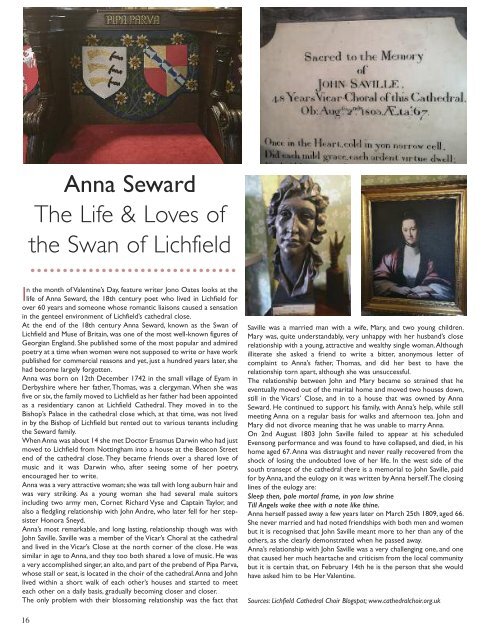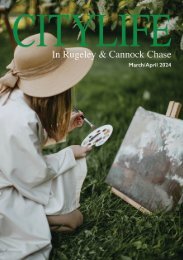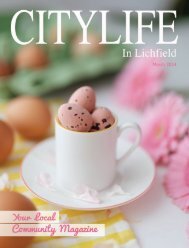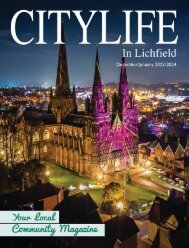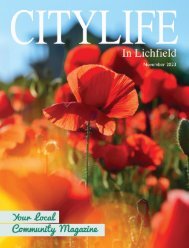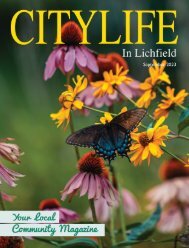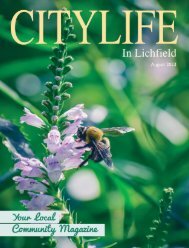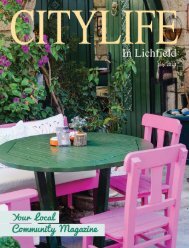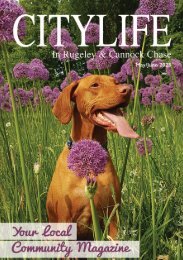Citylife in Lichfield February 2020
Love is definitely in the air in our February Valentine's Special edition! All the usual news, views, articles, competitions, recipes and history features are all here in this edition of Citylife in Lichfield - everything you want to know, explore and learn about Lichfield in one magazine!
Love is definitely in the air in our February Valentine's Special edition! All the usual news, views, articles, competitions, recipes and history features are all here in this edition of Citylife in Lichfield - everything you want to know, explore and learn about Lichfield in one magazine!
Create successful ePaper yourself
Turn your PDF publications into a flip-book with our unique Google optimized e-Paper software.
Anna Seward<br />
The Life & Loves of<br />
the Swan of <strong>Lichfield</strong><br />
................................<br />
In the month of Valent<strong>in</strong>e’s Day, feature writer Jono Oates looks at the<br />
life of Anna Seward, the 18th century poet who lived <strong>in</strong> <strong>Lichfield</strong> for<br />
over 60 years and someone whose romantic liaisons caused a sensation<br />
<strong>in</strong> the genteel environment of <strong>Lichfield</strong>’s cathedral close.<br />
At the end of the 18th century Anna Seward, known as the Swan of<br />
<strong>Lichfield</strong> and Muse of Brita<strong>in</strong>, was one of the most well-known figures of<br />
Georgian England. She published some of the most popular and admired<br />
poetry at a time when women were not supposed to write or have work<br />
published for commercial reasons and yet, just a hundred years later, she<br />
had become largely forgotten.<br />
Anna was born on 12th December 1742 <strong>in</strong> the small village of Eyam <strong>in</strong><br />
Derbyshire where her father, Thomas, was a clergyman. When she was<br />
five or six, the family moved to <strong>Lichfield</strong> as her father had been appo<strong>in</strong>ted<br />
as a residentiary canon at <strong>Lichfield</strong> Cathedral. They moved <strong>in</strong> to the<br />
Bishop’s Palace <strong>in</strong> the cathedral close which, at that time, was not lived<br />
<strong>in</strong> by the Bishop of <strong>Lichfield</strong> but rented out to various tenants <strong>in</strong>clud<strong>in</strong>g<br />
the Seward family.<br />
When Anna was about 14 she met Doctor Erasmus Darw<strong>in</strong> who had just<br />
moved to <strong>Lichfield</strong> from Nott<strong>in</strong>gham <strong>in</strong>to a house at the Beacon Street<br />
end of the cathedral close. They became friends over a shared love of<br />
music and it was Darw<strong>in</strong> who, after see<strong>in</strong>g some of her poetry,<br />
encouraged her to write.<br />
Anna was a very attractive woman; she was tall with long auburn hair and<br />
was very strik<strong>in</strong>g. As a young woman she had several male suitors<br />
<strong>in</strong>clud<strong>in</strong>g two army men, Cornet Richard Vyse and Capta<strong>in</strong> Taylor, and<br />
also a fledgl<strong>in</strong>g relationship with John Andre, who later fell for her stepsister<br />
Honora Sneyd.<br />
Anna’s most remarkable, and long last<strong>in</strong>g, relationship though was with<br />
John Saville. Saville was a member of the Vicar’s Choral at the cathedral<br />
and lived <strong>in</strong> the Vicar’s Close at the north corner of the close. He was<br />
similar <strong>in</strong> age to Anna, and they too both shared a love of music. He was<br />
a very accomplished s<strong>in</strong>ger, an alto, and part of the prebend of Pipa Parva,<br />
whose stall or seat, is located <strong>in</strong> the choir of the cathedral. Anna and John<br />
lived with<strong>in</strong> a short walk of each other’s houses and started to meet<br />
each other on a daily basis, gradually becom<strong>in</strong>g closer and closer.<br />
The only problem with their blossom<strong>in</strong>g relationship was the fact that<br />
Saville was a married man with a wife, Mary, and two young children.<br />
Mary was, quite understandably, very unhappy with her husband’s close<br />
relationship with a young, attractive and wealthy s<strong>in</strong>gle woman. Although<br />
illiterate she asked a friend to write a bitter, anonymous letter of<br />
compla<strong>in</strong>t to Anna’s father, Thomas, and did her best to have the<br />
relationship torn apart, although she was unsuccessful.<br />
The relationship between John and Mary became so stra<strong>in</strong>ed that he<br />
eventually moved out of the marital home and moved two houses down,<br />
still <strong>in</strong> the Vicars’ Close, and <strong>in</strong> to a house that was owned by Anna<br />
Seward. He cont<strong>in</strong>ued to support his family, with Anna’s help, while still<br />
meet<strong>in</strong>g Anna on a regular basis for walks and afternoon tea. John and<br />
Mary did not divorce mean<strong>in</strong>g that he was unable to marry Anna.<br />
On 2nd August 1803 John Saville failed to appear at his scheduled<br />
Evensong performance and was found to have collapsed, and died, <strong>in</strong> his<br />
home aged 67. Anna was distraught and never really recovered from the<br />
shock of los<strong>in</strong>g the undoubted love of her life. In the west side of the<br />
south transept of the cathedral there is a memorial to John Saville, paid<br />
for by Anna, and the eulogy on it was written by Anna herself. The clos<strong>in</strong>g<br />
l<strong>in</strong>es of the eulogy are:<br />
Sleep then, pale mortal frame, <strong>in</strong> yon low shr<strong>in</strong>e<br />
Till Angels wake thee with a note like th<strong>in</strong>e.<br />
Anna herself passed away a few years later on March 25th 1809, aged 66.<br />
She never married and had noted friendships with both men and women<br />
but it is recognised that John Saville meant more to her than any of the<br />
others, as she clearly demonstrated when he passed away.<br />
Anna’s relationship with John Saville was a very challeng<strong>in</strong>g one, and one<br />
that caused her much heartache and criticism from the local community<br />
but it is certa<strong>in</strong> that, on <strong>February</strong> 14th he is the person that she would<br />
have asked him to be Her Valent<strong>in</strong>e.<br />
Sources: <strong>Lichfield</strong> Cathedral Choir Blogspot; www.cathedralchoir.org.uk<br />
16


